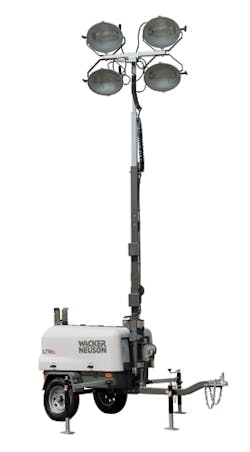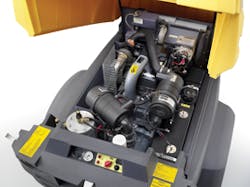Some contractors pack up the job-site trailer with everything but the kitchen sink, while others may travel light. Whether you’re the former, or the latter-or somewhere in between-it’s helpful to peruse some of the new job-site accessories and components available on today’s market. We’ll examine what’s new in portable generators, air compressors, wheel-wash systems, compact light towers, job-site security systems, mobile computers, tool-tracking software, and hardhat peripheral vision systems. Take a look at each and ask yourself: To have or have not? That is the question.
Powerful Portable Generators
According to Elkhart, IN-based Gillette Generators, it is very important to rent or buy a portable generator that is easy to operate, safe to use, and large enough to power the intended electrical load. Proper selection and sizing is based on a full understanding of generator function, features and benefits. Gillette offers a checklist of important genset features for job-site use.
Two choices of engine designs are available-the side-valve engine (SV) and the overhead-valve (OHV) design. Gillette says that the SV is an older design offering a less efficient operation, and that it should not be applied to heavy-duty equipment. Recent innovations have led to the OHV design which allows a very compact engine, lighter weight, fuel and oil consumption reduced up to 30%, low noise, and longer life.
Gillette recommends using the OHV engine, which delivers up to 3,000 hours of service life over the SV design and yields an approximate 1,000 hours of life between major overall repairs.
Certain engine features should be considered mandatory for job-site users. Gillette suggests the following: a low oil shutdown that will not allow engine restart until oil level is restored; an electric start for a portable generator size of 9,000 watts (16 horsepower) and larger; automatic decompression which automatically opens the exhaust valve to relieve pressure created by the compression stroke when engine cranking occurs; an automatic idle that lets the engine run at three-quarter speed without usable electric power output; and a dual air filter that reduces costly repairs over the single element filters.
Wacker Neuson’s LTN 6 features a stamped steel tub for protection.
Gillette says that of the many generator designs, the most popular is the brushless design which provides maintenance-free operation as there are no brushes to replace after every 600 to 800 hours of operation.
As to larger-kilowatt generator sets, built-in two-wheel dollies with large, full pneumatic tires should be specified for ease of transportation over rough job-site terrain by one person. Large, extended-run fuel tanks should be selected for uninterrupted power supply and the safety of less tank fill-ups during the work period. Special ground-fault-circuit interrupter (GFCI) receptacles should be used on all 120-V circuits up to 20 amps for an electric-shock protection for workers (as legislated by OSHA).
Gillette Generators describes itself as a total manufacturer of the largest assortment of portable generator sets. The company says it has specific control over all quality aspects as it winds its own generators with the latest automatic winding equipment and the highest-quality winding insulation systems-which, according to Gillette, offers an edge over offshore generator assemblies.
Chicago Pneumatic, a division of the Atlas Copco Group, offers a generator range available from 12 kVA to 30 kVA. The company recently introduced its new CPG 45 portable generator, which features an Interim Tier 4 Kubota diesel engine and a Stamford BCI series alternator to deliver 35 kW of prime power. Standard features include a multivoltage selector switch, remote start and stop capability, and a digital control system. A comprehensive instrument panel enables all key operation functions to be supervised without opening the canopy, and analog gauges provide at-a-glance monitoring, says the company. Finally, a 70-gallon fuel tank allows a 24-hour run time, and a spillage-free frame provides environmental protection. The CPG is designed to go 500 hours between service intervals.
Available from 3,000 through 11,000 watts, Baldor Electric Co. says its portable generators are designed for continuous operations.
The company offers several models: the fully featured Premier line; the maximum valued Powerchief line; and diesel. Baldor portables provide a “Switchless Full Pow’R” feature, which eliminates the voltage selector “power switch.” The Premier models also have an automatic idler feature, which reduces fuel consumption, and have a unique “Focal Vibration System,” which reduces vibration and eliminates “floor walking.”
Portable Air Compressors
The Web site www.aircompressorresource.com offers advice, buying guides and selection tips for all air compressor types and sizes. The site cautions against buying a piece of equipment that merely matches your minimum requirements. The tool or piece of equipment that has the highest PSI requirements will set your minimum, then upsize it a bit from there.
Sizing up the airflow is slightly more complicated, as instead of just choosing the highest rating among your tools, you need to add them all up. Collect the CFM (cubic feet per minute) requirements for all the tools or equipment you will use simultaneously. Take that combined total, and multiply it by 1.5. This will reveal a figure that accounts for some bleed or inefficiencies in the setup.
PSI and CFM requirements must be well defined. Some compressors can alternate between delivering higher pressure at lower airflow, and higher airflow at lower pressure. The site stresses choosing the model that delivers the volume of air needed at the right pressure.
A recently introduced portable air compressor line from Doosan Infracore is the new Platinum Series P185, which, the company says, combines the most valued features of the P185 legacy air compressors with design advancements that offer superior performance and value for rental customers particularly.
Doosan says that the noise level of the P185 air compressor has been reduced by 50%, while fuel efficiency is increased by 21%, providing the best-in-class, 10-hour, full-load runtime on one tank of fuel. Both cooling capacity and altitude performance have been improved to make the unit a welcome solution in more geographic areas than ever before.
Portable Wheel-Wash Systems
Designed for short-term construction projects or for the ease of rental installations, Innovative Equipment Solutions (IES) recently introduced a new super-compact and highly portable wheel-wash solution-The Tracinator-a one-tire-revolution dirt-removal system for light conditions, or for usage where a complete, heavier-duty wheel-wash system is not practical or budgeted. The Tracinator is designed to flush itself clear of debris by simply attaching a 2-inch hose from a water truck or fire hydrant, and placing the cleanout valve in the open position. Debris is then flushed out to the side through the open ports. As such, says IES, the Tracinator is a preferred and field-proven alternative to standard rumble grates, which require manual cleaning by using a shovel to clear debris from between the ribs.
For ease of installation, The Tracinator can be configured with a set of hinged ramps, which allow the system to be set up and operational in just minutes. Or, the system may be installed in-ground, flush with the existing road. In this case, a trough must be excavated on the open port side of the unit to allow rinse water to be directed away from the system.
IES stresses that the Tracinator streamlines operations while allowing companies to remain in compliance with regulations designed to prevent dirt and sediment from being tracked onto public roads from the job site.
According to Atlas Copco, using OEM filters helps eliminate the guesswork when maintaining a portable compressor. Portable air compressors play a big role on the job site. OEM filters can play a critical role in extending the performance life of a portable compressor and ensure it is working at optimum levels.Filtration: The Basics
Compressor element oil provides the necessary lubrication for the bearings and rotors. Keeping it clean through proper filtration increases compressor element and engine life, ensures optimal flow for reduced fuel consumption, and maintains the quality of the output air to any equipment. “Rotary screw compressors have very tight tolerances. The oil is the only thing that seals the veins or fins on the screw, which compresses the air,” says Matt Cadnum, Atlas Copco’s vice president of Aftermarket. “Therefore, if you get any kind of dirt or particulate matter in the oil, it will start wearing that screw, or element. If this starts wearing, you lose efficiency and air flow, and you burn more fuel. This is why filtration is so important.”
Filtration 1-2-3
There are essentially three stages of filtration for compressor element oil, and each stage must be operating efficiently in order to properly filter the entire system.
Air filter—As outside air flows into the rotary screw to be compressed, it must be filtered. The filtered air and the compressor element oil mix. Therefore, if the air filter has the wrong micron rating, is inefficient, or fits incorrectly and allows unfiltered air to enter the system, the oil will get dirty very quickly.
Compressor oil filter—Next, the compressor oil passes through a screw-on oil filter, the second stage of filtration. Key here is the presence of a bypass valve in the filter. If the compressor oil filter becomes clogged, this bypass valve allows the oil to pass through to continue to lubricate the parts and prevent extensive damage to the compressor. While this certainly isn’t ideal, “Dirty oil is better than no oil,” Cadnum points out. “A filter could have the wrong micron rating, and there are filters that don’t have bypasses to allow continued lubrication of the parts. This is why OEM parts are so important; you know you are using the correct filter.”
Separator element filter—During compression, oil and air mix together in the rotary screw. Centrifugal force then removes most of the oil before the air passes through a separator element. The separator element filter has the finest micron rating of all three filters to remove any remaining oil and very small particulates. If the particulate matter going into the final filter is too big—perhaps because incorrect filters were used during stages one and two—it will clog or tear very quickly. Oil will pass through and get into the output air.
Using OEM filters with the proper micron rating will help avoid these issues, but filters must also be changed at the proper interval, which is determined by the manufacturer or based on the working environment. Compressors are designed just like any other piece of equipment—to run in a fairly clean environment with moderate dust at moderate temperatures. However, if the compressor is working under extreme conditions—where there’s a lot of concrete dust, for example—then obviously the air filters will clog much more quickly and should be changed accordingly. “Most compressors in the field are running well below their maximum efficiency because they are poorly maintained,” says Cadnum. “As a result, contractors are using a lot more fuel than they have to and increasing the cost of ownership dramatically—sometimes by as much as 200%.”
By following the recommended service intervals, using OEM parts and maintaining the entire filtration system, your portable compressor
will operate at peak efficiency and perform when you need it.
—Material supplied by Atlas Copo
Compact Light Towers
Contractors are lighting up the job site with a new series of light towers from Wacker Neuson. According to the company, the new LTN 6 (Light Tower Narrow body, 6-kW generator) with its compact design takes up less room on the job site and/or in the rental yard, plus reduces freight costs by allowing 11 units to be transported on a truckload.
“Our new narrow light towers offer a revolutionary look,” says Marc Leupi, utility product manager for Wacker Neuson. “The housing has been changed from the box-metal style to a unique, streamlined, curved designed made from a high-impact plastic. This material is incredibly durable. It’s virtually dent- and rustproof, which extends the life of the unit, especially in the harsh elements.” Leupi continues, “These units are easier than ever to service. As part of the new housing, the doors on both sides extend the full length of the unit providing for easy and complete service access.”
Borrowing from the automotive industry, the LTN 6 is the first light tower to utilize a stamped 10-guage steel tub that provides superior strength and full protection from ground debris. “The fully enclosed bottom is also key to reducing sound emissions,” says Leupi. “The LTN 6 sound level is as low as 67 dBA at 23 feet, which is an impressive number when you consider the industry average is over 70 dBA.” This steel tub and all of the other metal surfaces, including the inner mast sections and outriggers, are protected by durable powder-coat paint, and all external hardware is zinc-dichromate-treated for extreme rust resistance.
Job-Site Security Systems
Anything can happen at the job site, from vandalism to theft to fires, and contractors are not always alerted to these situations before serious damage or loss occurs. The Contractor Guardian from Guardian Systems is a customizable wireless job-site security alarm system that provides notification against prevalent threats. The system acts as a virtual fence around a job site or trailer, using wireless sensors to detect unauthorized entry, smoke, heat, high water levels, loss of power, and low battery voltage. If an alarm is triggered, the system will call up to three phone numbers with an automated message within 30 seconds. Owners and managers can then take proper action. More information on this system and others can be found at www.guardianwireless.com.
The wireless job-site monitoring system and security camera from Eplanit, www.eplanit.com, is designed specifically for the construction site. Eplanit says it has integrated the latest technology in high-resolution cameras, wireless Internet, solar power and digital recording software. The Eplanit Mobile Construction Camera is completely self-contained, trailer-mounted, and stabilized and requires no external connections for full operation. The system sets up in less than an hour and its weighted base provides the same stability to wind as a fixed camera tower while still allowing easy relocation.
Remote monitoring and controlling of the camera is possible by logging into the project site from any computer to access a Network Video Controller (NVC), which allows the user to establish recording schedules, set patrol modes, create motion detection zones, and use Pan/Tilt/Zoom (PTZ) controls for each of the system’s cameras.
Mobile Computers
Even today, many job sites are run without mobile computers-and a desktop is often shared amongst project managers, superintendents and subcontractors in the project’s trailer. Motion Computing, www.motioncomputing.com, has introduced the Motion F5 Tablet PC to replace the standard laptop on construction projects, as the latter is bulky and difficult to use while walking around to inspect work or meet with subcontractors. The handle on the tablet makes the unit highly portable, and the integrated camera streamlines the photo documentation process, enabling users to seamlessly capture photos and make them part of the job-site record.
Doosan’s P185 air compressor can run for 10 hours on a tank of fuel.
Documents can be shared between a number of tablets and contractors can use large screen monitors in the job-site trailers to display documentation for discussions with project team members.
Tool Tracking
With many projects going on at once, headquarter offices may encounter difficulties in tracking who has what tool or component. And contractors are looking for ways to make workers assume more responsibility for expensive inventory on the job. There are many tool tracking options to choose from, most employing some sort of barcode or scanning system. ToolWatch software www.toolwatch.com offers comprehensive tracking ability via a database that manages everything involved in the life of a tool-from purchasing to repairs to warranties-to provide much-needed accountability. ToolWatch wireless scanning tools remotely transfer information back to the tool crib, keeping the database constantly up to date and giving users access to information from any location.
Hardhat Peripheral Vision System
Run-over and back-over accidents on the job site are a serious safety concern for the construction industry. OSHA categorizes “Struck-By” as one of the top four construction hazards. The American Society of Safety Engineers (ASSE) announced the approval of a new ANSI standard, which in section 5.2.2 says “mount mirrors on the flagger’s/worker’s hardhat.”
Designed to clip easily to most hardhats, the Goblin Peripheral Vision System, from Neuwaukum Industries,
www.hardhatmirror.com, alerts workers to movement around and behind them, reducing the risk of injury or death from approaching vehicles, heavy equipment, and other hazards. While the traditional rear-view mirror is in close proximity to the eyes and makes it difficult to focus, or distorts or blocks direct vision, the Goblin Peripheral Vision System mirrors alert the worker to movement without looking directly in them. When adjusted properly, the system expands peripheral vision up to 180 degrees without blocking direct vision. Additionally, using two mirrors (versus the traditional single mirror) alerts workers to danger from all directions.
Rent or Buy?
Finally, these new job-site accessories and many others are available for purchase or rental. A general rule of thumb is that if you don’t utilize a piece of equipment at least 60% to 70% of the time, you should consider renting.
“The rental trends for accessory equipment on job sites are very much tied to procurement policies for the contractors involved,” says Joe Dixon, vice president of sales for United Rentals. “In this economy, contractors have become more aware of the carrying costs of idle or semi-idle equipment. Even small machines can be a drain when you calculate storage, maintenance and parts. What we see most frequently is a base level of accessory equipment that is owned by the contractor outright, and supplemented by rentals when their needs spike on certain projects.”
When accessory equipment is rented, “we’re seeing a trend toward single sourcing,” says Dixon. “Increasingly, customers want to source the entire rental package from a single supplier to better leverage their spending.”
Whether you rent or buy, ask yourself: What are the must-have accessories for the next job site? That is the question.














